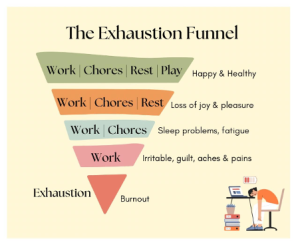As the year comes to a close, many people find themselves feeling drained. If this resonates with you, understanding the Exhaustion Funnel model might offer insight into how burnout develops and provide practical steps to restore balance in your life.
What Is the Exhaustion Funnel?
The Exhaustion Funnel, developed by Professor Marie Åsberg at the Karolinska Institute, shows what happens when we don’t have a balance between responsibilities and nourishing activities. The top of the funnel shows a healthy life where duties are balanced with activities that energise and replenish us. As stressors increase, we often sacrifice these “optional” activities to focus on what feels urgent.
Over time, the funnel narrows as we give up more of what sustains us. We might stop exercising, cooking healthy meals, or spending time with loved ones. This narrowing leads to a vicious cycle: without replenishment, our energy reserves become depleted, leaving us more exhausted and less equipped to handle stress, and spiralling down to the bottom of the funnel.
The Cost of Neglecting Self-Care
Self-care often feels indulgent or selfish, especially when we are overwhelmed with responsibilities. However, ignoring our need to recharge is like expecting our car to go without fuel—it’s unsustainable. We may fall into maladaptive coping habits like binge-watching series, scrolling on social media, skipping meals, or indulging in junk food or alcohol. These quick fixes might offer temporary relief but ultimately deplete our energy further.
If you are burnt out, you may experience symptoms such as:
- Increased irritability.
- A shrinking social life or feeling isolated.
- Avoidance of routine chores.
- Fatigue and loss of motivation.
- Changes in sleep and eating habits.
- Procrastination.
Why High Achievers Are Prone to Burnout
Those most at risk of burnout are often the most dedicated and conscientious individuals. Their commitment to work and others often overshadows their own needs, making it easy for them to fall into the funnel. The belief that self-care can wait until there’s more time is a trap—if stressors remain constant, delaying self-care only makes things worse.
Climbing Out of the Funnel
If you recognize yourself in the funnel, there is hope. The first step is acknowledging the need for change and committing to small, intentional actions that restore balance. Key strategies include:
- Rest: Prioritize sleep and downtime to allow your body and mind to recover.
- Exercise: Even light physical activity can boost energy levels and improve mood.
- Play: Engage in activities that bring joy and creativity, like a hobby, time with friends, or something spontaneous.
- Change Expectations: Let go of unrealistic standards about what you “should” accomplish. Be kinder to yourself. Set boundaries.
- Practice Mindfulness: bring present moment awareness and calm into your day.
Self-care is not a luxury; it’s a necessity. By making small daily changes—whether it’s enjoying a nourishing meal, taking a walk, or simply pausing to rest—you can begin to climb out of the funnel.
Why Balance Matters
Cutting out nourishing activities might seem like an efficient way to handle stress, but it backfires in the long run. Without time to replenish, we become less productive, less creative, and less capable of handling our responsibilities.
Remind yourself that self-care is an investment in your overall well-being and effectiveness. Every act of care—no matter how small—can help you regain your energy, climb out of the exhaustion funnel, and create a more sustainable life.
By reclaiming balance, we not only improve our own lives but also become better equipped to meet our responsibilities and support those around us. Remember: taking care of yourself isn’t selfish; it’s essential.

 "
"